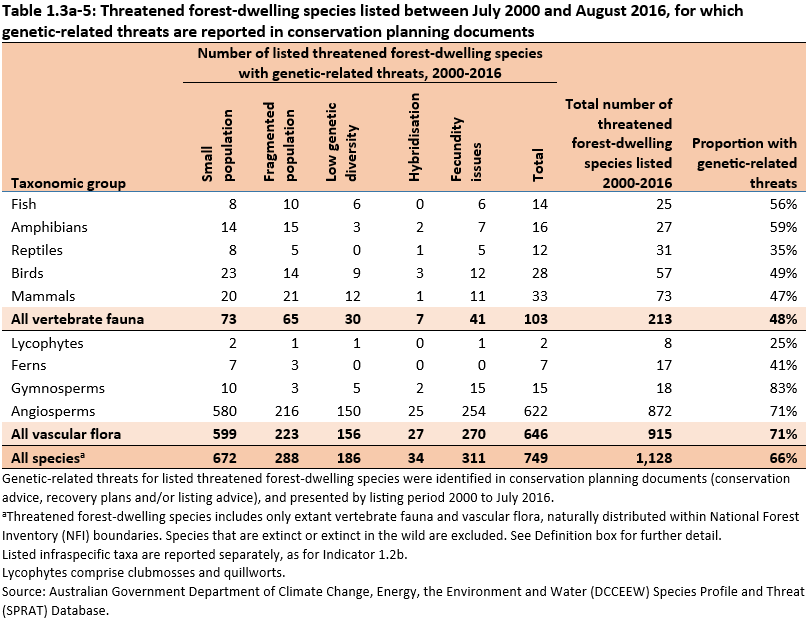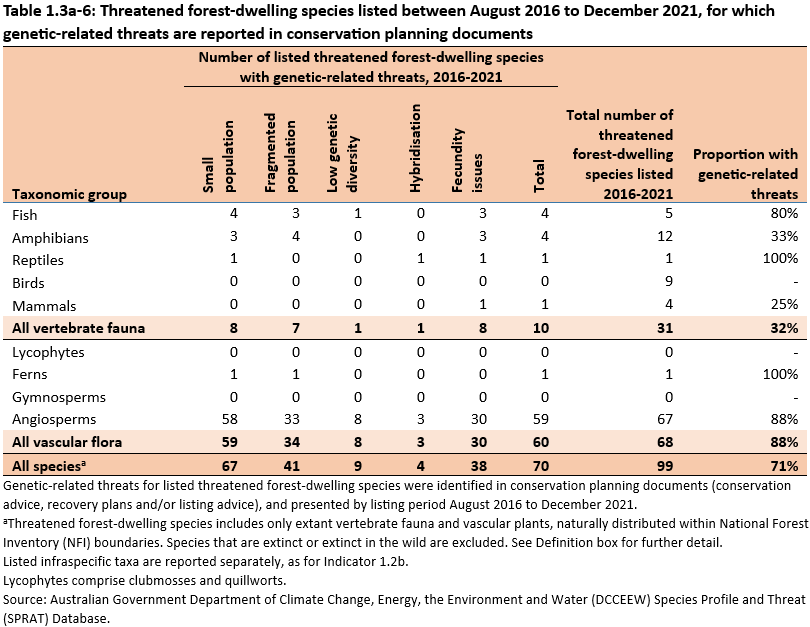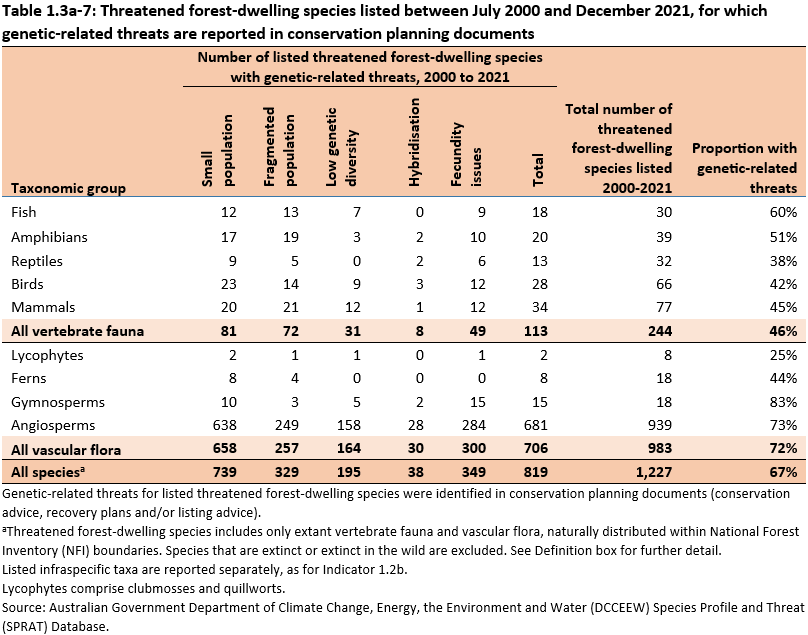This is Supporting information for Indicator 1.3a, published October 2024.
Genetic-related threats were assessed for all 244 listed threatened forest-dwelling vertebrate fauna and 983 listed threatened forest-dwelling vascular flora described in Indicator 1.2b The status of forest dwelling species at risk of not maintaining viable breeding populations, as determined by legislation or scientific assessment (2024), and were allocated to the threat categories small population, fragmented population, low genetic diversity, hybridisation and fecundity issues according to information in species conservation planning documents (conservation advice, recovery plans and/or listing advice).
Compared to Australia’s State of the Forest Report 2018, this update only includes species occurring in forest within the National Forest Inventory boundaries (excluding species endemic to offshore territories), excludes invertebrate fauna and non-vascular plants, excludes extinct species, and excludes species re-assessed as not forest-dwelling. Genetic-related threats of all 1,277 threatened forest-dwelling species are assessed based on the information outlined in the most up-to-date conservation planning documents.
The full list of listed threatened forest-dwelling species with their associated genetic (and other) threats is available for download from forest species and ecological communities data.
Small populations
This threat category relates to number of mature individuals and population size, or to area of occupancy and extent of distribution. In general, ‘small’ includes total population size ≤1,000 individuals or comprising ≤10 subpopulations, or with geographic distribution precarious for the survival of the taxon (i.e. restricted area of occupancy <500 km2 and/or severely fragmented) (IUCN 2022). A genetic-related threat in this category was only recognised where the conservation advice or recovery plan specifically indicated that the taxon is at risk of inbreeding or other genetic bottlenecks due to the small size or isolated nature of its population.
Fragmented populations
Population fragmentation is considered as a genetic threat where the conservation documents specify severe population fragmentation, with most individuals of a taxon found in isolated subpopulations (IUCN 2022). When conservation documentation only specify fragmentation without describing its severity, information on population density and dispersal distance was used to determine if the fragmentation inhibits gene-flow or reduces population viability.
Low genetic diversity
This category is used when the conservation documentation specifies low genetic diversity, highly clonal species, or species with only one population containing an extremely low number of individuals.
Hybridisation
This category is used when the conservation documentation specifies hybridisation as a risk to a species. Hybridisation with other species can increase genetic diversity and viability (genetic rescue) but can also drive species to extinction where the rare genetic form is replaced by hybrids.
Fecundity issues
Fecundity is a measure of the number of fertile offspring that survive to reproductive age, and can be reduced by a range of threats that stop offspring maturing successfully to breeding age. Examples include young plants of obligate seeder species (plants that only regenerate after fire from seed) killed by fire before flowering age, predation of eggs or juvenile animals, intensive grazing that prevents plants to produce seeds, or the absence of pollinators.
Tables 1.3a-5–7 present data for threatened forest-dwelling species, by species groups, listed under the Environment Protection and Biodiversity Conservation Act 1999 (EPBC Act) by genetic-related threats for three listing periods: July 2000 and August 2016, August 2016 to December 2021, and the combined July 2000 to December 2021.
Click here for a Microsoft Excel workbook of the data for Table 1.3a-5.
Click here for a Microsoft Excel workbook of the data for Table 1.3a-6.
Click here for a Microsoft Excel workbook of the data for Table 1.3a-7.
IUCN (2022). Guidelines for Using the IUCN Red List Categories and Criteria, Version 15.1. Prepared by the Standards and Petitions Committee.
Further information
- Key points
- Risks to forest genetic variation
- Genetic-related threats to threatened forest-dwelling species
- Change in genetic-related threats over time
- Conservation measures to mitigate genetic-related risks
Downloads
- Indicator 1.3a: Forest associated species at risk from isolation and the loss of genetic variation, and conservation efforts for those species (2024) - PDF [0.2 MB]
- Tabular data for Indicator 1.3a - Microsoft Excel workbook [0.1 MB]
- Forest-dwelling species and threatened forest ecological communities of Australia dataset (2024) - Microsoft Excel workbook [1.3 MB]
- Metadata - Forest-dwelling species and threatened forest ecological communities of Australia dataset (2024) - PDF [0.2 MB]



